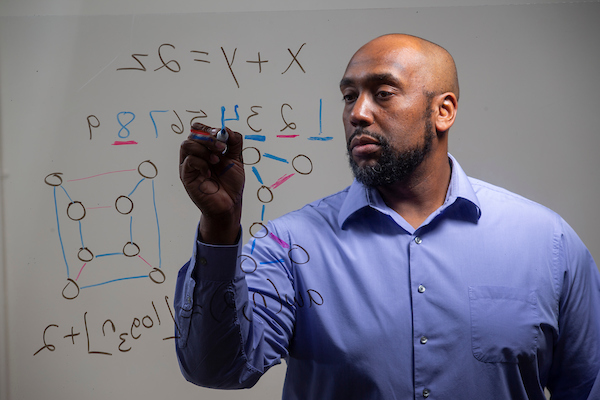Michael Young secures $1.5 million NSF grant to study the successful experiences of students of color in math Ph.D. programs


According to the American Mathematical Society, less than 5% of graduates who earn a Ph.D. in mathematics are people of color.
Michael Young, associate professor of mathematics, is determined to boost those numbers and a recently awarded $1.5 million grant from the National Science Foundation (NSF) could help him to achieve these goals.
“Results from this research could impact—and possibly transform—how colleges recruit, admit and support students of color in graduate mathematics programs across this country,” Young said.
The NSF grant will fund a three-year study in which Young will analyze the successful experiences of Ph.D. mathematics students who hail from underserved populations, such as minorities and women.
“It’s important to study the experiences of high-achieving students of color who report positive experiences in these programs,” Young said. “Their insight will allow us to aggregate the data and pinpoint the exact methods, conditions and strategies that enable these students to fully engage and thrive during their academic journeys.”
Applying the data to real-world solutions
Young plans to formalize the study’s results and create a “best-practices manual” that will outline strategies for building and maintaining diverse student populations in math Ph.D. programs. He’ll also organize workshops where college decision makers can learn how to attract and create support services for students of color.
As the project’s principal investigator, Young will design, develop and manage a survey instrument. His team will collaborate to identify and survey participants. These interviewees will include minority students who have applied to, enrolled in or recently graduated from a math Ph.D. program.
Two co-principal investigators will collaborate with Young: Sarah Sword, senior research scientist from the Education Development Center in Waltham, Massachusetts; and Carl Westine, assistant professor of educational research at the University of North Carolina, Charlotte.
Awarded by the NSF’s competitive Education Core Research Program, this grant will support Young’s research until 2022. The project will also fund five graduate students who will contribute ongoing research to the project.
Motivated by firsthand experience
Young’s passion for expanding diversity in graduate mathematics programs stems from his experiences as a Ph.D. student at Carnegie Mellon University and his nine years as a faculty member in Iowa State’s Department of Mathematics.
While earning his Ph.D. in mathematics, Young overcame significant cultural and academic obstacles. He credits his success to supportive faculty who provided tailored guidance and personalized services. Young’s graduate school experiences provide the backbone of the post baccalaureate (postbac) certificate in mathematics, a program that Young co-founded with Bernard Lidický, associate professor of mathematics.
The postbac program helps undergraduate math degree holders smoothly transition into the rigors of Iowa State’s graduate mathematics program. Program features include academic and non-academic guidance from faculty mentors as well as programs and services. Using a 360-degree approach, these students are wholly supported—from their first day of class to the completion of their dissertation.
The majority of Iowa State’s postbac students hail from underrepresented groups.
The potential for meaningful impacts
Extending beyond the scope of Iowa State, Young’s research could potentially impact thousands of graduate students from across the United States.
“Results from the study will arm graduate directors, admissions personnel and faculty with data-driven recommendations, tactics and programs, which will help them to expand diversity in their programs,” Young said.
For Young, it’s about removing barriers to entry and creating more seats at the table for underserved populations and students of color.
“Attuning graduate schools to fit the needs of students of color could unfreeze that 5% statistic—and increase it to 10%, 20%, or 30% and beyond—which is ultimately the long-term goal of our research,” Young said.